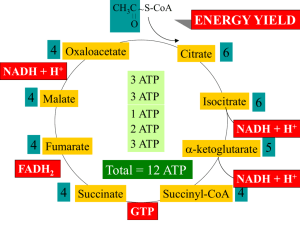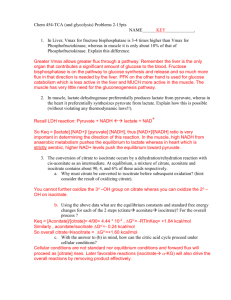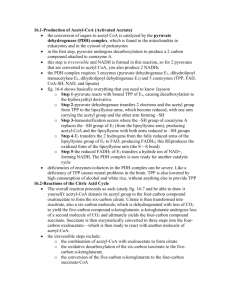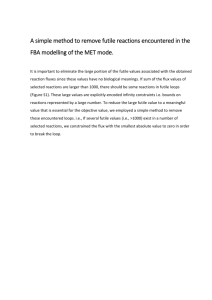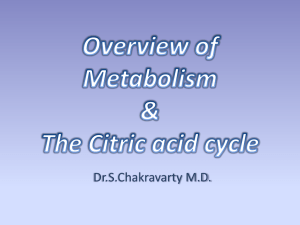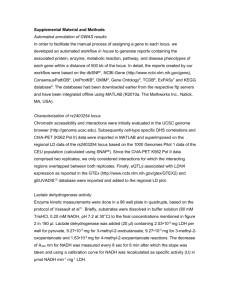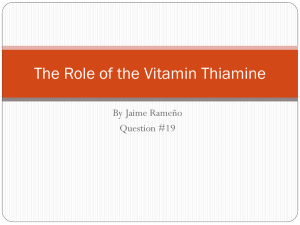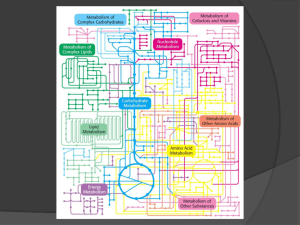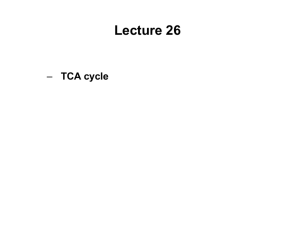2 - 動物科學系
advertisement
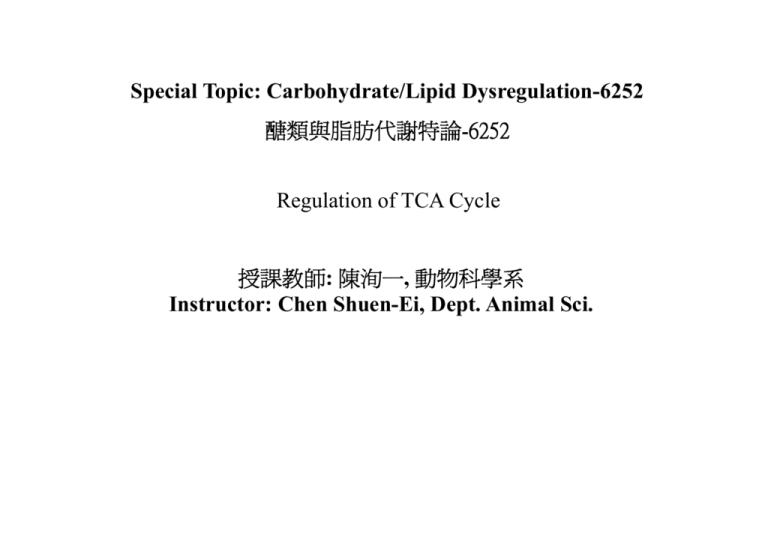
S i l Topic: Special T i Carbohydrate/Lipid C b h d t /Li id D Dysregulation-6252 l ti 6252 醣類與脂肪代謝特論-6252 Regulation g of TCA Cycle y 授課教師: 陳洵一, 授課教師 陳洵一 動物科學系 Instructor: Chen Shuen-Ei, Dept. Animal Sci. 2 CO2 released No CO2 N release (TCA) Summary of Reactions Substrate or Cofactor Energy Citrate synthase Acetyl CoA, OAA Aconitase (± H2O) Isocitrate dehydrogenase releases CO2 NAD+ 3 ATP α-Ketoglutarate dehydrogenase NAD+ 3 ATP Succinyl-CoA synthetase GDP, Pi 1 ATP S i t dehydrogenase Succinate d h d FAD 2 ATP Fumarase (H2O) Malate dehydrogenase NAD+ Feature releases CO2 GTP 3 ATP TOTAL 12 ATP GTP Table 1. Summary of Enzymes and Specific cofactor or products in the Krebs Cycle Cit t + 3NAD+ + FAD + GDP + Pi + H2O Citrate [1] Oxaloacetate + 3NADH + 3H+ + FADH2 + 2CO2 + GTP 6 4 2 9 ATPs 2 ATPs 1 ATP Where do we get all that energy? Citrate + 3NAD+ + FAD + GDP + Pi + H2O [1] + Oxaloacetate + 3NADH + 3H + FADH2 + 2CO2 + GTP 1. How energetic is citrate? 6C Carbons b C l Turns T = 3 Cycle = 3 x 12 ATP per cycle = 36 ATPs A 2. How energetic is oxaloacetate 4 Carbons = 2 Cycle turns to Citrate = 24 ATPs 3. How energetic g is malate 4 Carbons = 2 Cycle turns + 1 NADH= 27 ATPs Regulation of the Kreb’s Cycle Pyruvate Dehydrogenase complex Pyruvate + TPP → Acetal-TPP + CO2 Acetal-TPP + S-S → Ac-S ^ SH + TPP Ac-S ^ SH + HS-CoA → AcS-CoA + HS ^ SH HS ^ SH + FAD → S-S + FADH2 FADH2 + NAD+ → FAD + NADH + H+ Pyruvate y uvate + HS-CoA S Co + N NAD+ → Acetyl-CoA cety Co + N NADH + H+ Regulators-Activators Regulators- Inhibitors and AMP Fatty acids and ATP Key Regulatory Points: Pyruvate dehydrogenase Complex Inhibited by NADH and Acetyl-CoA NADH [NAD+] Acetyl-CoA HS CoA HS-CoA High NADH means that the cell is experiencing a surplus l off oxidative id i substrates b and d should h ld not produce d more. Carbon flow should be redirected towards synthesis. High Acetyl-CoA means that carbon flow into the Krebs cycle l is i abundant b d t and d should h ld b be shut h td down and d rechanneled h l d towards biosynthesis (TCA) Mechanism: Text p621 1. Competitive Inhibition NADH and acetyl-CoA reverse the pyruvate dehydrogenase reaction by competing with NAD+ and HS-CoA 2. Covalent Modification (second level regulation) E-11 subunits of PDH complex is subject to phosphorylation E TPP Active FAD HPO4= 1 2 Insulin 3 E1-OH PDH phosphatase H2O ATP PDH kinase E1-OPO OPO3 Inactive ADP Epinephrine Glucagon Cyclic-AMP Cyclic AMP protein kinase ATP Regulation of Cycle Enzymes Enzyme Citrate Synthase Aconitase Isocitrate dehydrogenase α-Ketoglutarate dehydrogenase Succinyl-CoA Synthase Succinate dehydrogenase Fumarase Malate dehydrogenase y g ΔGo’ (kJ/mol) -31.5 ~5 -21 -33 -2.1 +6 -3.4 +29.7 All regulatory enzymes occur in the first half of the cycle Regulation of the Citric Acid Cycle Primary modes: 1. Substrate availability (key enzymes are subsaturated) Allostery is not a primary mode 2. Product inhibition 3. Feedback inhibition (competitive) Key regulators: 1 Acetyl-CoA (controls citrate synthase) 1. 2. OAA (controls citrate synthase, regulated by NADH) 3. NADH (controls citrate synthase, isocitrate dehydrogenase 4 Calcium 4. C l i (stimulates ( ti l t NADH production) d ti ) Equilibria to Consider O2 consumption NADH oxidation id ti ATP production Tightly coupled: affect one is to affect all Malate + NAD+ Controls NADH and is controlled by NADH OAA + NADH A A working muscle will increase respiration and oxidize NADH. This stimulates i l OAA synthesis h i which hi h stimulates citrate synthase and isocitrate dehydrogenase reactions reactions. Malate + NAD+ OAA + NADH Substrate limited [OAA][NADH] K = [Malate][NAD+] Citrate K [Malate][NAD+] [OAA][NADH] Isocitrate dehydrogenase α-Kg dehydrogenase Respiration (O2) Respiration Increases P 621 Pyruvate Dehydrogenase Citrate Synthase No Regulation Isocitrate Dehydrogenase α-Ketoglutarate Dehydrogenase
